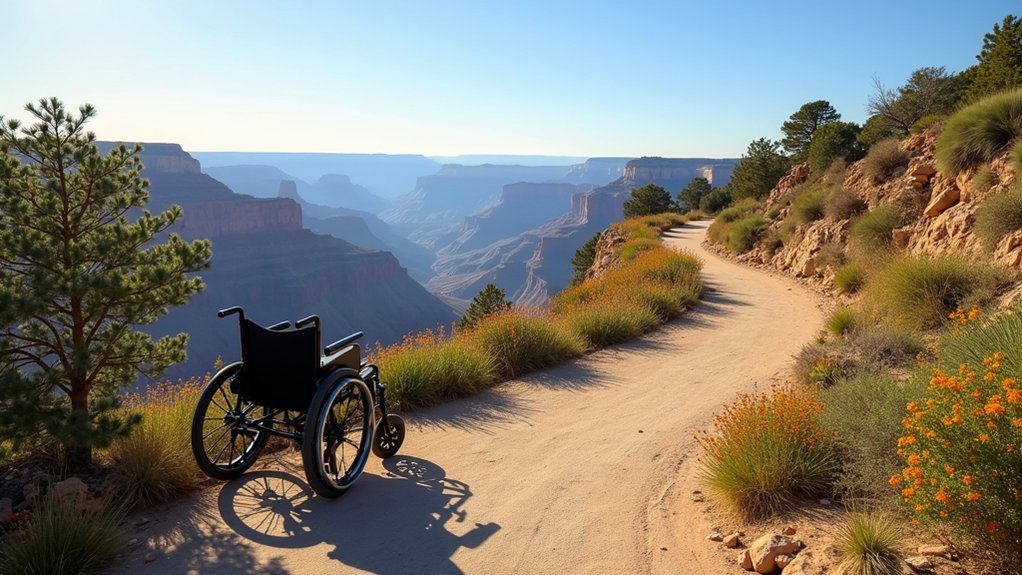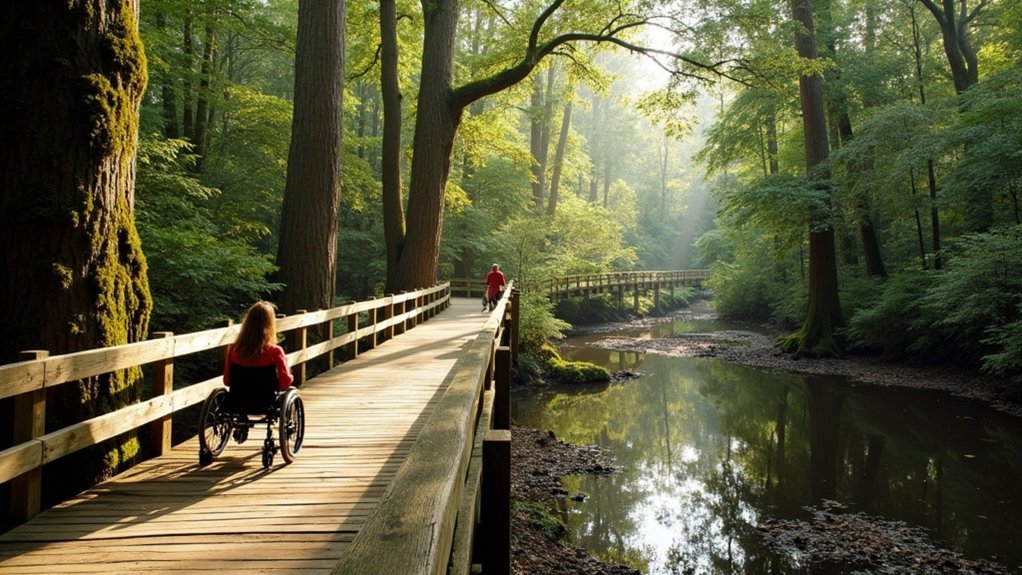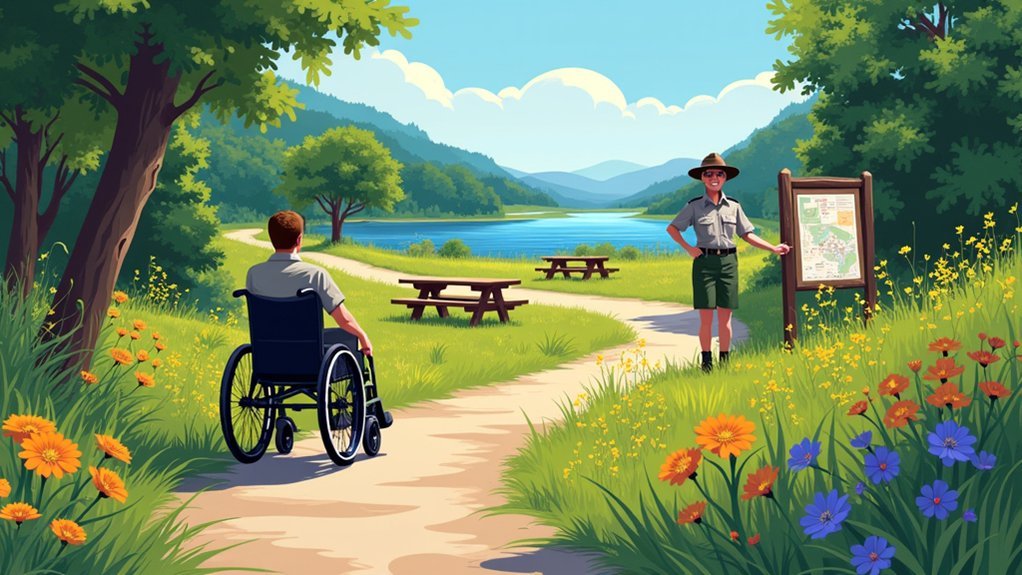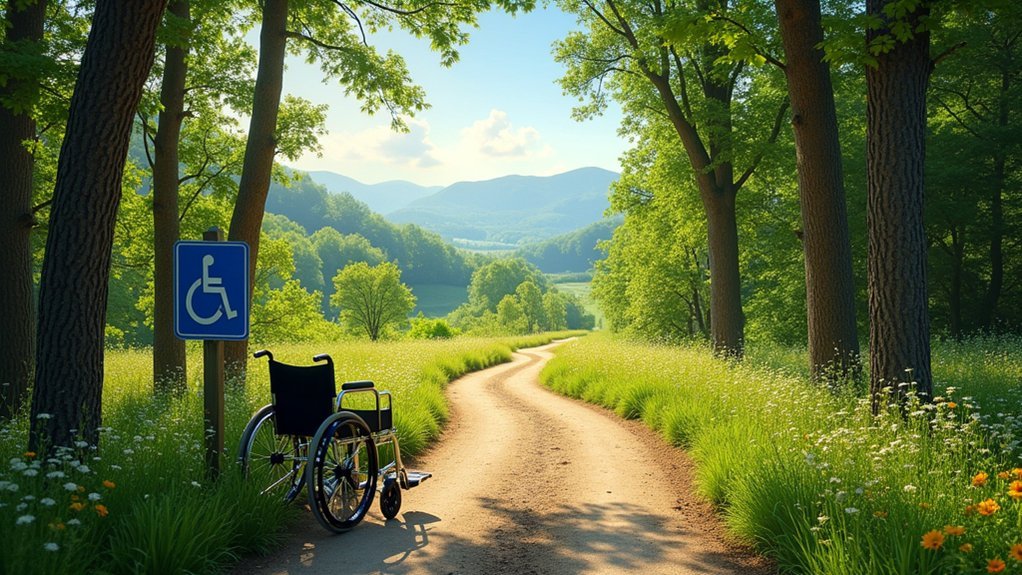You’ll find numerous wheelchair-friendly trails throughout America’s national parks. The Grand Canyon offers a 13-mile paved South Rim Trail, while Yellowstone features accessible boardwalks around geothermal wonders. Don’t miss Congaree’s 2.4-mile elevated Boardwalk Loop or Sequoia’s paved Big Trees Trail. Many parks provide free Access Passes for visitors with disabilities, accessible campsites, and specialized equipment like sand wheelchairs. These barrier-free pathways open up natural wonders to explorers of all mobility levels.
Navigating the Grand Canyon’s Barrier-Free South Rim Pathways

How can one of America’s most rugged landscapes be accessible to wheelchair users? The Grand Canyon’s South Rim offers a stunning 13-mile paved Rim Trail that accommodates wheelchairs from the South Kaibab Trailhead to Hermits Rest.
The Grand Canyon welcomes everyone, proving natural wonders can be experienced regardless of mobility challenges.
You’ll find this trail particularly welcoming with its gentle, mostly flat terrain and minimal obstacles. As you travel along, you’ll pass iconic landmarks like Mather Point, Hopi House, and the historic El Tovar hotel.
Don’t worry about completing the entire route—you can explore a section and then use the wheelchair-accessible shuttle buses to return. The trail provides scenic views perfect for leisurely walks while remaining accessible to all visitors.
Designated handicap parking spaces are available at viewpoints throughout the South Rim, and wheelchair rentals can be obtained at Bright Angel Bicycles.
Remember to check your wheelchair dimensions, as shuttles accommodate chairs up to 30 inches wide by 48 inches long.
Yellowstone’s Accessible Boardwalks Around Geothermal Wonders
While most visitors imagine Yellowstone’s otherworldly geothermal features as remote and inaccessible, the park actually offers an impressive network of wheelchair-friendly boardwalks that bring you remarkably close to these natural wonders.
You’ll find accessible boardwalks at key geothermal areas including Old Faithful, Mammoth Hot Springs, and Norris Geyser Basin. These paths connect directly from parking areas with designated accessible spaces. Most feature gentle slopes and include accessible restrooms nearby. Yellowstone is recognized as one of the best national parks for accessibility by various media outlets.
| Location | Experience |
|---|---|
| Old Faithful | Watch eruptions from multiple accessible viewing areas |
| Mammoth Hot Springs | Marvel at terraced formations via connected boardwalks |
| West Thumb | Enjoy wheelchair-friendly paths alongside stunning lake views |
The park provides detailed accessibility guides, and you can use the NPS Yellowstone app with its “Wheelchair Access” filter to plan your visit.
Exploring Ancient Forests on Congaree’s Elevated Boardwalk Loop

You’ll gain unique perspectives of Congaree’s ancient forest ecosystem from the 2.4-mile elevated Boardwalk Loop Trail, which remains accessible even during flooding periods.
The trail features strategically placed platforms where you can observe diverse wildlife, including glowing fungi at night and the mysterious cypress knees that continue to intrigue scientists. The boardwalk connects directly to the Harry Hampton Visitor Center, providing convenient access to information, restrooms, and refreshments.
Wheelchair-accessible benches along the route offer comfortable rest spots to take in the sights and sounds of one of North America’s most biodiverse forests.
Elevated Forest Perspectives
Hidden beneath the canopy of ancient trees, Congaree National Park’s Boardwalk Loop Trail offers wheelchair users an immersive 2.4-mile journey through one of America’s most diverse forest ecosystems. Visitors can admire national champion trees that thrive in this remarkable old-growth forest. You’ll experience minimal elevation changes as you glide along the level boardwalk that’s designed to remain accessible even during flooding periods.
| Feature | Accessibility Benefit |
|---|---|
| Elevated design | Remains accessible during floods |
| Rubber-matted surfaces | Improved traction and safety |
| Benches and turnouts | Regular rest opportunities |
| Minimal grade (≤5°) | Easy navigation for wheelchairs |
| Varied ecosystems | Views of both swamp and hardwood forests |
The boardwalk’s elevation gives you a unique perspective of the forest floor and surrounding habitats. When you need assistance, the Harry Hampton Visitor Center offers wheelchair loans and accessible facilities including restrooms and water stations.
Wildlife Viewing Platforms
Congaree’s elevated boardwalk doesn’t just showcase forest perspectives—it provides strategic wildlife viewing platforms that transform your park experience.
The 2.4-mile wheelchair and stroller accessible trail features turnout points where you’ll spot diverse birdlife and aquatic creatures within the ancient swamp and hardwood forest.
You’ll find convenient benches at these viewing platforms, offering perfect resting spots to quietly observe the protected ecosystem.
Even during flooding periods, you’ll remain safely above water while witnessing the dynamic floodplain environment. The park’s conservation efforts protect these diverse habitats, ensuring wildlife continues to thrive.
The boardwalk introduces visitors to a remarkable hardwood forest with numerous tree species and wildlife that call Congaree National Park home.
For a more educational experience, pick up the Self-guided Boardwalk Tour brochure before setting out.
Remember to check trail conditions before visiting, as water levels can affect accessibility beyond the elevated sections.
Among Giants: Wheelchair-Friendly Trails in Sequoia National Park
Nestled among the world’s largest trees, Sequoia National Park offers several wheelchair-friendly trails that make the majesty of these ancient giants accessible to visitors of all mobility levels.
The 0.75-mile paved Big Trees Trail circles Crescent Meadow with gentle slopes and accessible rest areas, perfect for enjoying the sequoias’ grandeur. The popular General Sherman Tree Trail provides a paved path with gentle inclines to view the largest tree on earth.
You’ll find these accessibility features throughout the park:
- Free wheelchair rentals at visitor centers on a first-come, first-served basis
- Wheelchair-accessible shuttles connecting major attractions during summer months
- Accessible scenic drives allowing you to enjoy spectacular views without hiking
For visitors with disability placards, you’ll have special access to restricted areas like Moro Rock/Crescent Meadow Road, enhancing your experience of this magnificent natural wonder.
Planning Your Visit: Accessibility Services and Permits in National Parks

Planning a memorable trip to national parks involves more than just selecting which natural wonders to visit. For visitors with mobility needs, understanding available accessibility services is essential for a smooth experience.
Contact the park service before your visit to inquire about specific accommodations. The National Park Service offers free lifetime Access Passes to U.S. citizens or permanent residents with qualifying disabilities.
The National Park Service provides Access Passes at no cost for eligible visitors with disabilities—call ahead for details.
You’ll find many parks provide accessible campsites, which you can reserve in advance to guarantee availability. Parks like Yellowstone ensure there is a minimum of one wheelchair-accessible site in all campgrounds. Request reasonable modifications like accessible transportation or sign language interpreters when needed.
Check for accessibility maps and guides to help plan your route through the park. Many visitor centers offer tactile features and audio descriptions for enhanced experiences.
Remember to review emergency procedures as part of your preparation.
Top Wheelchair-Accessible National Park Experiences Across America
National parks across America offer remarkable wheelchair-accessible experiences that won’t compromise your sense of adventure or connection with nature.
You’ll find iconic viewpoints fully accessible at places like Grand Canyon’s South Rim, underground wonders at Carlsbad Caverns, and serene waterfront trails at Acadia National Park. The Trail of Time at Grand Canyon allows visitors to experience a geological timeline where each meter represents one million years of Earth’s history.
Whether you’re looking for desert landscapes, forest paths, or mountain vistas, wheelchair-friendly trails exist in diverse regions from Yosemite in California to Bryce Canyon in Utah.
SUBHEADING DISCUSSION POINTS
America’s most breathtaking natural wonders have become increasingly accessible to wheelchair users through thoughtfully designed trails and facilities.
When visiting national parks, you’ll find a variety of wheelchair-friendly experiences that showcase stunning landscapes without compromising accessibility. The National Park Service ensures accessible shuttle buses are available in several parks including Grand Canyon, Yosemite, and Zion to help visitors reach trailheads more easily.
- Yellowstone National Park offers 16 accessible trails including a boardwalk to Old Faithful Geyser, allowing you to experience this iconic natural phenomenon up close.
- Bryce Canyon’s 5-mile paved shared-use path takes you from Bryce Canyon City to Inspiration Point, providing spectacular views of the park’s famous hoodoos.
- Yosemite National Park features the Lower Yosemite Fall Trail, a half-mile paved route with boardwalk sections that brings you close to one of America’s most magnificent waterfalls.
Many parks also offer wheelchair rentals and detailed accessibility information on their websites to help plan your visit.
Iconic Views Without Barriers
While many visitors once believed exploring national parks required rugged hiking, today’s wheelchair users can access some of the most spectacular vistas our park system offers.
Rocky Mountain National Park’s paved Bear Lake Trail delivers breathtaking alpine scenery without barriers. You’ll find ADA-compliant paths throughout the park, complemented by free all-terrain wheelchair rentals that expand your exploration options.
You can experience Yosemite’s magnificent waterfalls via the Lower Yosemite Fall Trail, marvel at Grand Canyon’s vastness from accessible viewpoints, or drive Acadia’s loop road to witness coastal Maine’s beauty.
Don’t miss Carlsbad Caverns’ elevator access to underground wonders or Yellowstone’s wheelchair-friendly Lone Star Geyser Trail. Yellowstone’s Grand Prismatic Spring boardwalk allows visitors to safely witness the vibrant colors of America’s largest hot spring while remaining on a fully accessible path.
Most parks also offer accessible campgrounds—like Moraine Park and Glacier Basin—plus interactive visitor centers that enhance your understanding of these natural treasures.
Regional Accessibility Highlights
From coast to coast, wheelchair users can discover remarkable experiences in different regions of America’s national parks. Each area offers unique accessible adventures that showcase the country’s diverse landscapes.
- Northeast Gems – Acadia National Park stands out with 45 miles of wheelchair-accessible carriage roads, while the raised wooden boardwalks of Jesup Path immerse visitors in Maine’s coastal forests.
- Southwest Wonders – The Grand Canyon’s South Rim provides paved trails with spectacular views, and Carlsbad Caverns’ elevator access lets everyone explore its underground marvels. Great Sand Dunes National Park offers visitors the chance to explore with sand wheelchairs available on loan from the visitor center.
- Western Majesty – Yosemite’s Lower Yosemite Fall Trail offers wheelchair users an up-close experience with one of America’s most iconic waterfalls.
While Redwood National Park provides accessible paths among the world’s tallest trees.
Texas Treasures: Accessible Trails in the Lone Star State’s National Parks
The Lone Star State offers several nationally protected treasures with wheelchair-friendly pathways for outdoor enthusiasts of all abilities. Big Bend National Park features the Window View Trail, a fully accessible 0.3-mile self-guiding route perfect for experiencing desert landscapes without difficult terrain. Guadalupe Mountains National Park showcases the natural beauty of West Texas with its Pinery Trail, a 0.7-mile paved pathway with educational exhibits about Chihuahuan Desert plants.
| Trail Name | Location | Accessibility Features |
|---|---|---|
| Window View Trail | Big Bend | Fully wheelchair accessible, 0.3 miles |
| Chisos Basin Trails | Big Bend | Scenic views, accessible facilities |
| Rio Grande Overlooks | Big Bend | Paved pathways to river views |
| Visitor Center Paths | All Parks | Indoor exhibits, outdoor viewing areas |
When planning your visit, contact park rangers for current accessibility conditions. Don’t forget to inquire about free lifetime passes available to permanently disabled U.S. residents and accessible rafting opportunities on the Rio Grande.
Essential Gear and Preparation for Wheelchair Adventures in National Parks

Starting national park adventures with a wheelchair requires thoughtful preparation and specialized equipment to guarantee both safety and enjoyment. Choose the right mobility equipment for your destination—rugged all-terrain wheelchairs for unpaved trails or lightweight travel chairs for paved paths.
Your preparation checklist should include:
- Protective gear – Breathable clothing layers, sun protection, sturdy gloves, and weatherproof outerwear to handle variable conditions.
- Navigation tools – Accessible trail maps, GPS apps specifically for wheelchair users, and communication devices with ranger contact information.
- Safety supplies – First aid kit, extra batteries for power wheelchairs, plenty of water, energy-rich snacks, and emergency signaling devices.
Contact park visitor centers before your trip to verify accessibility features and available accommodations. Researching trail conditions ahead of time is crucial as rocky trails can significantly impact mobility and overall enjoyment of your outdoor experience.
Frequently Asked Questions
Do Any Parks Offer All-Terrain Wheelchairs for Loan?
Yes, you’ll find that some parks offer all-terrain wheelchairs for loan. Yellowstone provides both manual and beach wheelchairs, but availability varies across parks. Check specific park websites for rental information before visiting.
Are Service Animals Permitted on Wheelchair-Accessible Trails?
Yes, you’ll find that service animals are permitted on wheelchair-accessible trails in national parks per ADA guidelines. They must remain under your control, and some parks may require identification vests or harnesses.
What Accessible Lodging Options Exist Near Popular National Parks?
You’ll find accessible lodging at Yosemite’s Curry Village, Yellowstone’s Western Cabins, and near Shenandoah, Mount Rainier, and Blue Ridge Parkway. All feature roll-in showers, grab bars, and ramped entries for your comfort.
How Do Weather Conditions Affect Wheelchair Trail Accessibility?
Weather greatly impacts your wheelchair trail experience. Rain creates slippery surfaces, snow makes paths impassable, and extreme heat can be challenging. You’ll want to check park updates regularly for current trail conditions before visiting.
Are Tactile Maps or Audio Guides Available for Visually Impaired Visitors?
Yes, you’ll find tactile maps at most visitor centers upon request, and many parks offer audio guides through apps or devices. These tools help visually impaired visitors navigate trails and understand attractions independently.
In Summary
You’ll find more wheelchair-friendly trails in national parks than ever before. From the Grand Canyon’s South Rim to Yellowstone’s boardwalks, these accessible paths let you experience America’s natural wonders firsthand. Don’t forget to check each park’s accessibility services before you go. With proper planning and the right gear, you’re set for incredible adventures that showcase our nation’s commitment to making nature accessible for everyone.





Leave a Reply